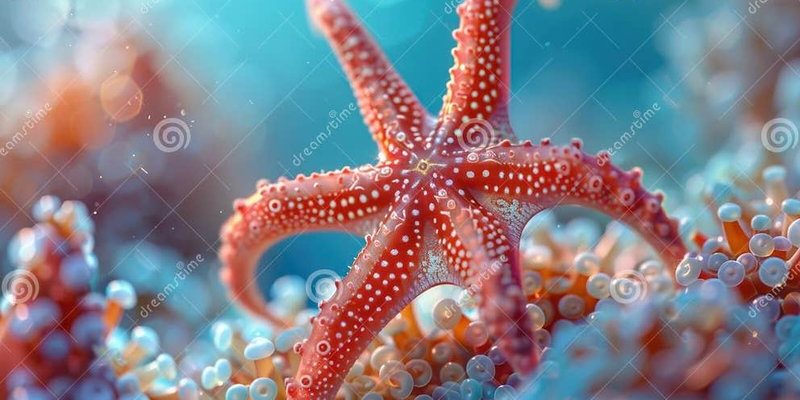
Starfish, or sea stars as some call them, are more than just pretty faces. They are crucial players in the complex web of marine life. Just as gardeners nurture plants and control pests in a garden, starfish help regulate populations of various marine species, ensuring that no single group takes over. Let’s dive deeper into what makes these echinoderms so essential to our oceans.
Understanding the Starfish
To appreciate the starfish’s role, it’s helpful to know a bit about what they are. These marine animals belong to the class Asteroidea and are characterized by their star-shaped bodies, typically featuring five arms, although some species have more. They come in many colors, shapes, and sizes, giving each species its unique charm. A few might even have a texture resembling a rough, scaly surface, while others are smooth and sleek, like a polished stone.
But it’s not just their looks that are intriguing. Starfish are fascinating because they can regenerate lost arms, a bit like having a superpower. If a starfish loses an arm, it can grow back over time. This ability helps them survive encounters with predators, which is a significant advantage in their often dangerous underwater home.
The Starfish’s Feeding Habits
One of the most remarkable things about starfish is how they eat. They’re known for their unique feeding method that involves their stomachs. Seriously, here’s the thing: when a starfish finds its meal—often clams or oysters—it can extend its stomach out of its body and into the shell of its prey! This process allows them to digest their food outside their bodies, which is pretty wild if you think about it.
This feeding technique not only satisfies their appetite but also plays a critical role in the marine ecosystem. By preying on bivalves like clams, starfish help regulate their populations. If those bivalves were left unchecked, they could overpopulate and harm the balance of the ecosystem, much like weeds overtaking a garden. So, in this sense, starfish act as natural population controllers.
Starfish and Coral Reefs
Coral reefs are some of the most diverse ecosystems on Earth, and starfish contribute significantly to their health. They help maintain the balance by preying on certain species that can threaten coral, like sponges and sea urchins. For example, the Crown-of-Thorns starfish, while often viewed as a threat due to its rapid reproduction and appetite for coral, also plays a role in controlling sponge populations, which can smother coral if they grow unchecked.
However, an overabundance of these starfish can lead to coral degradation. That’s why it’s crucial to maintain a balance. When starfish populations fluctuate, they can either promote coral growth or lead to its decline. This delicate balance illustrates just how interwoven these creatures are within their environment, much like threads in a tapestry.
Starfish as Indicators of Ocean Health
You might be wondering how starfish relate to the overall health of our oceans. They are often considered important indicators of marine ecosystem balance. Changes in their populations can signal larger environmental issues, like water quality or temperature fluctuations. For example, if starfish numbers begin to dwindle, it might indicate problems such as pollution or climate change adversely affecting their habitat.
Studying starfish can give scientists clues about ocean health and help them track changes over time. This is vital for conservation efforts, as understanding these creatures helps in managing marine resources sustainably. They are like the ocean’s early warning system, alerting us to problems we might need to address before they escalate.
Threats to Starfish Populations
Despite their resilience, starfish face several threats, many of which are connected to human activities. Climate change is a significant factor, leading to warmer ocean temperatures and increased ocean acidification. These changes can alter their habitats and affect their food sources, leading to declines in their populations.
Additionally, pollution from plastics and other waste can harm starfish directly or disrupt their food chains. Overfishing and destructive fishing practices can also indirectly affect starfish by altering the balance of their ecosystems. As these threats increase, conservation efforts become more critical to protect these important creatures.
Conservation Efforts for Starfish
Fortunately, many organizations and researchers are dedicated to starfish conservation. These efforts include habitat protection, studying starfish populations, and implementing sustainable fishing practices. For example, some marine parks and reserves work to safeguard habitats while allowing for monitored fishing to maintain ecological balance.
Community awareness is also crucial. Engaging local communities in conservation efforts can lead to more sustainable practices and a greater understanding of marine ecosystems. After all, when people appreciate the beauty and importance of creatures like the starfish, they’re more likely to support actions to protect them.
The Future of Starfish in Marine Ecosystems
As we look at the future, it’s clear that starfish will continue to play a vital role in our oceans. Protecting their habitats and ensuring their populations remain stable is essential for the health of coral reefs and marine ecosystems as a whole. Each of us can contribute, whether it’s by supporting conservation efforts or spreading awareness about the importance of these unique creatures.
Just like every piece in a puzzle is crucial to complete the picture, starfish are integral to the vibrant tapestry of underwater life. So, the next time you admire the ocean, remember the starfish and their work behind the scenes. Their presence helps keep the ocean healthy and thriving, and that’s something worth celebrating.

